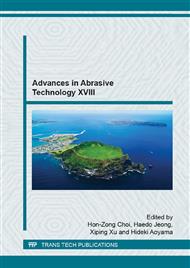[1]
F.Z. Fang, H. Wu, W. Zhou, X.T. Hu, A study on mechanism of nano-cutting single crystal silicon[J], Journal of Materials Machining Technology, 2007, 184: 407-410.
DOI: 10.1016/j.jmatprotec.2006.12.007
Google Scholar
[2]
Parash Kalita, Ajay P. Malshea, S. Arun Kumar, et al. Study of specific energy and friction coefficient in minimum quantity lubrication grinding using oil-based nanolubricants[J], Journal of Manufacturing Processes, 2012, 14: 160-166.
DOI: 10.1016/j.jmapro.2012.01.001
Google Scholar
[3]
Vijayender Singh, P. Venkateswara Rao, S. Ghosh, Development of specific grinding energy model[J], International Journal of Machine Tools& Manufacture, 2012, 60: 1-13.
DOI: 10.1016/j.ijmachtools.2011.11.003
Google Scholar
[4]
S. Ghosh, A. B. Chattopadhyay, S. Paul, Modelling of specific energy requirement during high-efficiency deep grinding[J], International Journal of Machine Tools & Manufacture, 2008, 48: 1242– 1253.
DOI: 10.1016/j.ijmachtools.2008.03.008
Google Scholar
[5]
T.W. Hwang, C. J. Evans, S. Malkin, Size effect for specific energy in grinding of silicon nitride[J], Wear, 1999, 225–229: 862–867.
DOI: 10.1016/s0043-1648(98)00406-2
Google Scholar
[6]
T.W. Hwang, S. Malkin, Upper bound analysis for specific energy in grinding of ceramics[J], Wear, 1999, 231: 161–171.
DOI: 10.1016/s0043-1648(98)00283-x
Google Scholar
[7]
Spur. G., Holl. S-E., Material Removal Mechanisms during Ultrasonic Assisted Grinding[J], Production Engineering, 1997, 12: 9-14.
Google Scholar
[8]
K. Egashira, T. Masuzawa, Micro-ultrasonic Machining by the Application of Work-piece Vibration[J], CIRP Annals-Manufacturing Technology, 1999, 48(1): 131-134.
DOI: 10.1016/s0007-8506(07)63148-5
Google Scholar
[9]
E. Uhlmann, G. Spur, Surface Formation in Creep Feed Grinding of Advanced Ceramics with and without Ultrasonic Assistance[J], CIRP Annals - Manufacturing Technology, 1998, 47(1): 249-252.
DOI: 10.1016/s0007-8506(07)62828-5
Google Scholar
[10]
Xu XP, Li Y, Malkin S., Forces and Energy in Circular Sawing and Grinding of Granite[J]. Transactions of ASME, Journal of Manufacturing Science & Engineering, 2001, 123 (1): 13-22.
DOI: 10.1115/1.1344900
Google Scholar
[11]
Chen J. Y, Xu X, P. Study on Specific Grinding Energy of Alumina Grinding with a Brazed Diamond Wheel in High Speed Regime[J]. China Mechanical Engineering. 2013, 7(24): 890-894.
Google Scholar


